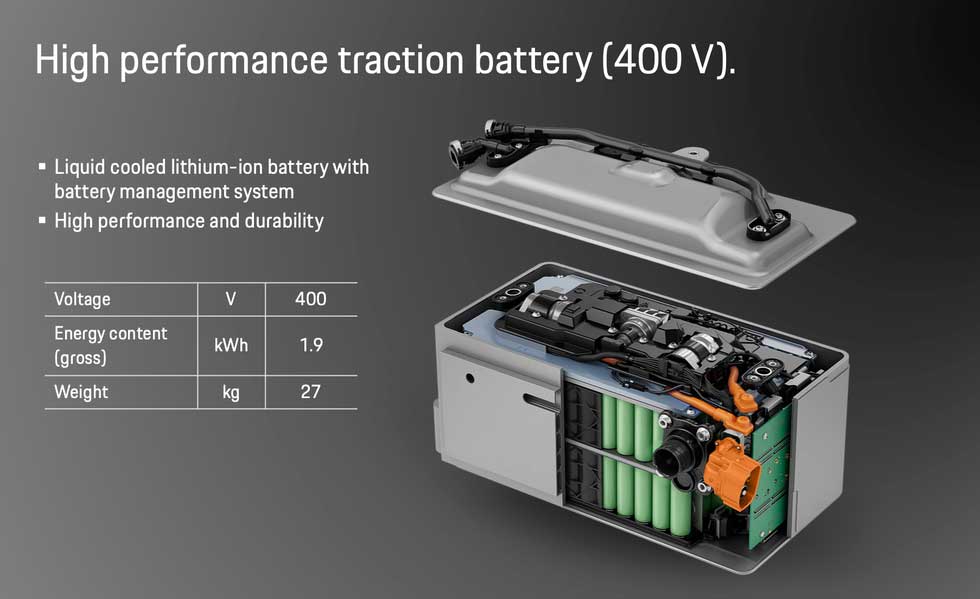The T in T-Hybrid stands for Turbo
The late-model Porsche 911 992 will have its world premiere on May 28, 2024When the new model was announced, the GTS model was the first to be announced as a hybrid model (as well as the non-hybrid base model Carrera with a twin-turbo engine).
In the announcement, Porsche spoke of the GTS as if it were the most natural thing in the world, saying, "The T-Hybrid is here." I kept thinking, "Huh? What's a T-Hybrid? This is the first time I've heard of it. I wonder if there'll be an explanation later." But in the end, there was no explanation (lol), and the only thing that remained in my mind was the mysterious word "T-Hybrid."
After doing some research, I found that Porsche had officially explained what the T-Hybrid is (not in a magazine article or anything), so it finally made sense to me.
As many people initially thought, "Doesn't the T in T-Hybrid stand for Turbo?", the T in this T-Hybrid does indeed stand for Turbo.

Frank Moser, currently head of the 911/718 at Porsche AG, said in the video that "the name 'Turbo-Hybrid' or 'T-Hybrid' for short comes from the electric exhaust gas turbocharger."
Now I understand ^^!
Now, based on the video and other data released by Porsche, I would like to look at other information about this hybrid 911 GTS... but as you all know, I don't understand technical things, so I'll just keep it brief (sorry for the quick summary (lol)).
I am translating without a sufficient level of understanding, so if you don't understand what is being said, I would appreciate it if you could check the source information at the end of this page and the original video above.
Porsche 911 GTS (992.2) T-Hybrid
The electric turbocharger fitted to the 992.2 Porsche 911 GTS has an electric motor between the compressor and turbine, and this electric motor creates rapid boost pressure regardless of engine speed, making it a hybrid powertrain that takes the same approach as F1.

- System output is 398kW
- 541 horsepower (61 horsepower increase from the previous model)
- 0-100km in 3.0 seconds
- The maximum speed is 312 km/h.
This is said to be a complete overhaul of the 911 engine that debuted in the 2017 model 991.2, and the 992.2 GTS is equipped with a 3.6-liter 9A3B6 engine instead of the 3.0-liter twin-turbo 9A2B6 used in the 992.1.
It uses an electrically enhanced single turbocharger, complemented by a powerful electric motor/generator that shares the housing with the eight-speed PDK transmission, all running on a 400-volt electrical system.
New bigger and smaller engines
The 9A3B6 shown in the photo above has had its bore and stroke increased from 91.0x76.4mm to 97.0x81.0mm, increasing displacement from 2,981cc to 3,591cc.
However, the space required has been reduced, by around 11cm from top to bottom, thanks to the placement of the hybrid system's power control electronics between the top of the engine and the 911's classic sloping engine cover.
The oil filter has been moved from the top to the bottom of the engine to maintain accessibility.
Not only is the new engine's intake manifold smaller, but the cylinder head has also been redesigned, and the valvetrain now uses finger followers which have less friction than the previous generation bucket tappets.
The changes eliminate the previous engine's VarioCam plus variable valve lift, which was no longer needed to widen the torque curve, and these heads have larger intake and exhaust ports to increase engine throughput.
Furthermore, by reducing the size of the crankshaft counterweight, they were able to reduce weight by just over 1.8 kg without affecting smoothness.
Other changes, such as eliminating the auxiliary drive, have reduced the overall engine weight by around 18kg to around 208kg.
Lambda 1 and its penalty

Compared to the 9A2 engine in the 992.1 GTS, the 9A3 engine's compression ratio has been increased from 10.2:1 to 10.5:1, and peak boost pressure has increased from 18.6 to 26.1 psi.
These changes, combined with the increased displacement, result in much more boost for roughly the same displacement as the 992.1 911 Turbo S.
However, while power has increased by 5hp, maximum torque has not increased from 570Nm, which is due to Lambda 1, a perfectly balanced fuel to air ratio at all engine operating points.
Sorry, I don't understand it anymore lol.
For decades, all modern engines have run on a Lambda 1 air-to-heat ratio, which produces the only exhaust gas that can reduce all three major smog pollutants in a three-way catalyst.
The engine runs slightly rich only at full throttle, which rarely occurs during emissions testing, to increase power by around 21 TP1T, reduce temperatures to maintain engine and catalyst life, and inhibit detonation in turbocharged engines.

By eliminating the possibility of using rich mixtures during boost operation (up to 8% rich in the 992.1GTS), peak combustion chamber temperatures increase to a point where ignition timing must be significantly retarded to control detonation.
This results in a significant drop in power output. It seems that adding boost can make up for some of this loss, but the higher the boost, the higher the intake temperature, which has the opposite effect.
So, to offset these somewhat, the 9A3 engine is fitted with a single intercooler rather than the two smaller ones on the previous engine.
This approach apparently provides more surface air to better cool the intake charge.
So why did Porsche stick with Lambda 1?
The reason for this is apparently that Germany has automotive regulations that require Lambda 1 under all operating conditions.
There are exceptions for certain high-performance engines where a power boost may be justified, but Porsche has decided to follow this regulation with the 9A3 engine.
So although the engine and boost are bigger, there's been almost no increase in power, and it runs much cleaner even at full power.
Single electric turbocharger

Instead of the twin turbos of the 992.1 GTS, the 992.2 GTS was fitted with a single turbo with a 20kW motor mounted between the compressor and exhaust sides of the turbo, and the motor was fitted with roller bearings on both ends.
The rotational energy provided by this motor significantly reduces turbo lag at low RPMs.
For example, with the throttle closed at 2,000 rpm, the previous GTS took more than three seconds to reach full boost when the throttle was wide open, whereas the new GTS does it in just under one second. Amazing.

The new electric turbo is manufactured by BorgWarner and is significantly larger than the previous model.
Whereas the previous GTS (and S and 992.2 base) units had diameters of 55mm on the compressor side and 8mm on the exhaust side, the new GTS units are 83mm and 80mm respectively, to accommodate the much larger volume of air being moved.
This unit has no wastegate, instead the electric motor acts as a generator at higher RPMs to produce up to 15 horsepower... drawing enough power from the turbine to keep the turbo from exceeding its 125,000 rpm redline.
The electricity generated is sent to the battery and electric motor as needed, supplementing the overall power supply from around 5,700 rpm at full throttle.
Asymmetrical exhaust system

This big single turbo is bigger than the old twin-turbo that was mounted on either side of the engine, so Porsche engineers decided to place it on the right-hand side of the engine and route exhaust gases from the cylinders on the left bank of the engine to it using a crossover manifold.
The combined weight of the turbo and manifold is approximately 27 kg, which is the same as the combined weight of an old-style twin turbo and manifold.
Because the turbo is on the right, the engine's muffler fits into the space on the left, making the most of the available volume with a configuration that looks more like a small fuel tank than a regular cylindrical muffler.
With no auxiliary drive at the rear of the engine, the turbo exhaust is routed to the muffler intake by a large pipe, which houses a catalyst and particulate filter that Porsche says is a very low-restriction device that has little effect on engine power.
No accessory drive
Engine accessories have also been significantly simplified, eliminating the need for a starter and generator as the 54 horsepower motor mounted to the transmission serves both functions.
The new GTS has much more power than a conventional starter, so it starts up immediately when you activate the starter.
A small motor runs the air conditioning compressor at 400 volts, and the water pump has been moved inside the engine and is powered by an extension of the oil pump, eliminating the need for external belts to power the accessories.
Motor/Generator

Now, the final power generating element is the motor/generator attached to the 8-speed PDK gearbox.
The eight-speed transmission has gears arranged on four shafts instead of two, making it more compact in the front-to-rear direction and freeing up space for the electric motor.
It is a permanently excited synchronous design providing up to 40 kW and approximately 150 Nm of torque.
The motor is attached to the flat-six engine without a clutch, meaning it cannot run on electricity alone, but the motor provides enough torque to supplement the engine power at low speeds.
Therefore, the short lag in the pressure rise of the electric turbocharger can be reduced by adding electric drive torque.
Lithium-ion battery

A lithium-ion battery consists of 216 cells divided into two layers. Each layer of 21,700 cells (21mm diameter, 70mm length) is wired in series, so 108 cells multiplied by 3.7 volts per cell equals 400 volts.
The layers are wired in parallel to form a battery with a maximum total energy capacity of 1.9 kWh. It weighs around 27kg, is roughly the same size as a regular 911 lead-acid battery, and is housed in roughly the same position, just in front of the windscreen - a little to the right of centre.
Porsche's Frank Moser is said to promise that there will be no need to worry about the word "hybrid" when it comes to the 911.
It may not be the best for those who want a classic 911, but I'm sure it's a great 911 for the modern era. I'm looking forward to it!
Source:
◆Things You Must Know about Porsche's 911 GTS T-Hybrid Powertrain
◆Everything You Need to Know About the Porsche 911's New Hybrid Engine
Related article:
◆Porsche 911 992.2 Hybrid GTS vs previous ICE GTS
◆Porsche 911: Comparison of appearance between early 992 and late 992
◆Porsche 911 (992.2) What does the T in T-Hybrid mean? About the new Porsche 911 T-Hybrid powertrain
◆992.2 Porsche 911 main specifications and standard equipment list (GTS, 4GTS, Targa 4GTS, Carrera)
◆Porsche 911 (992.2 type) world premiere: 911 Carrera and GTS unveiled
◆Other 992.2 related articles can be found here
◆Porsche 911 992.2 review now available

